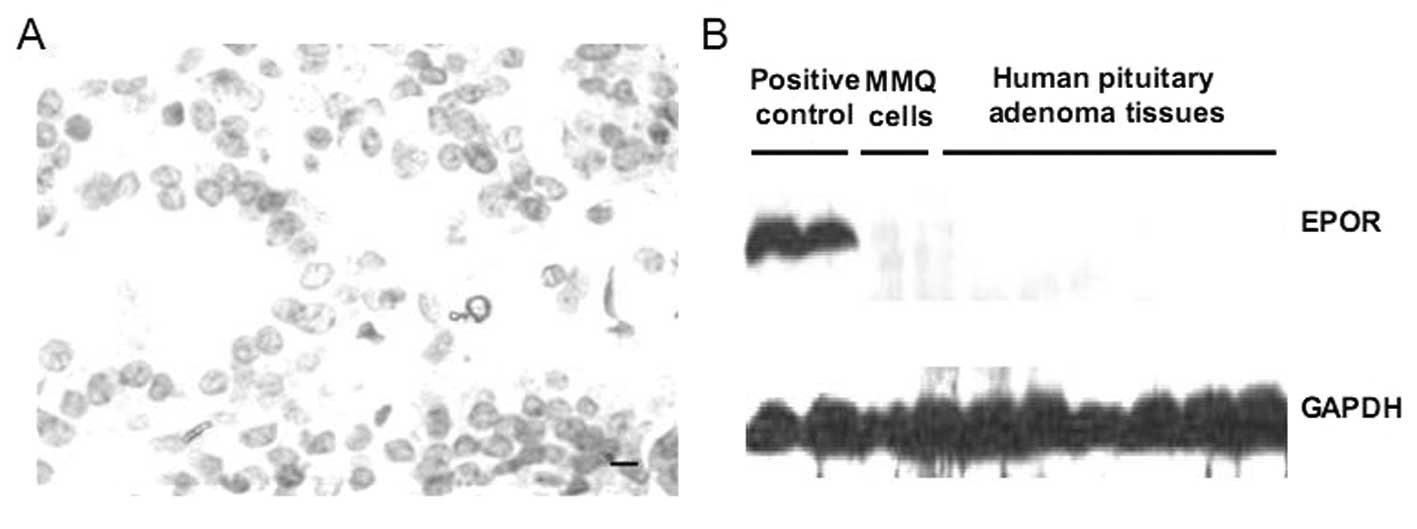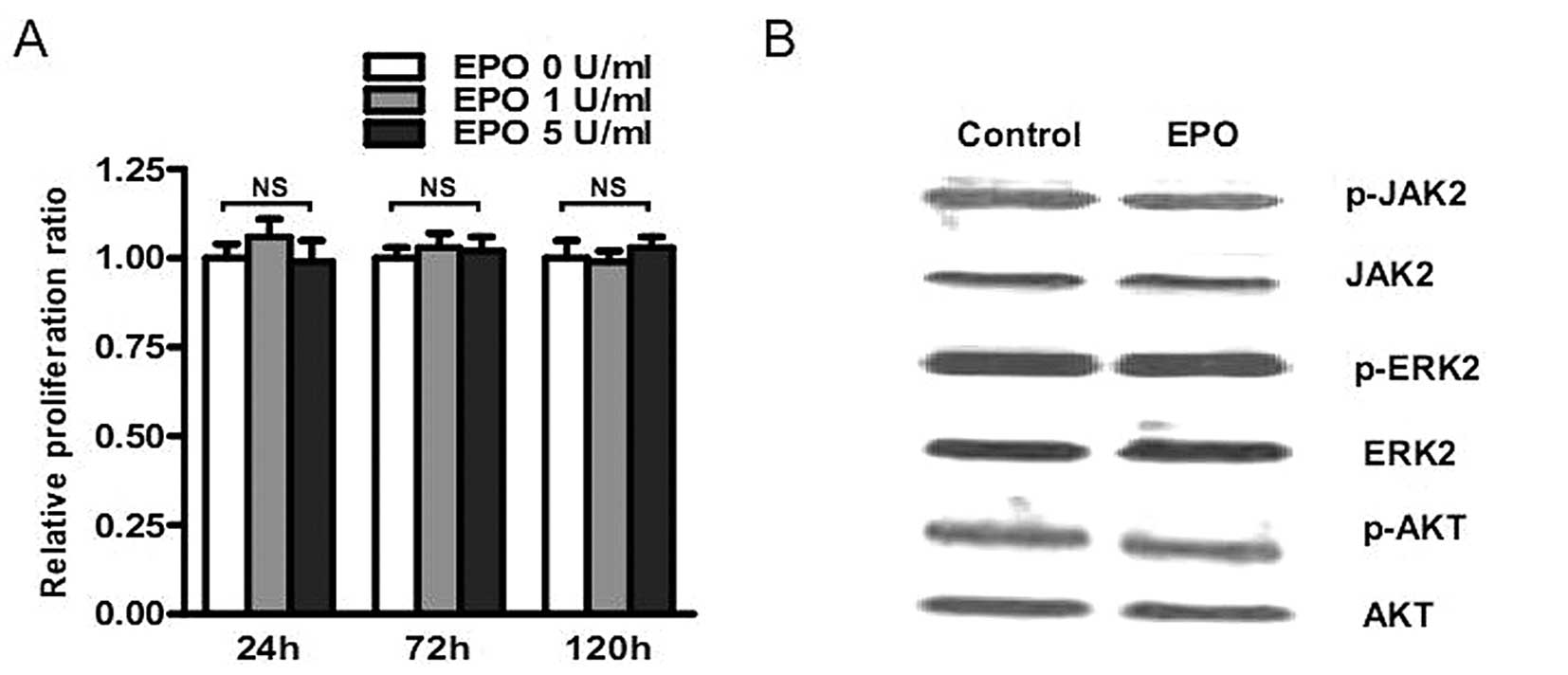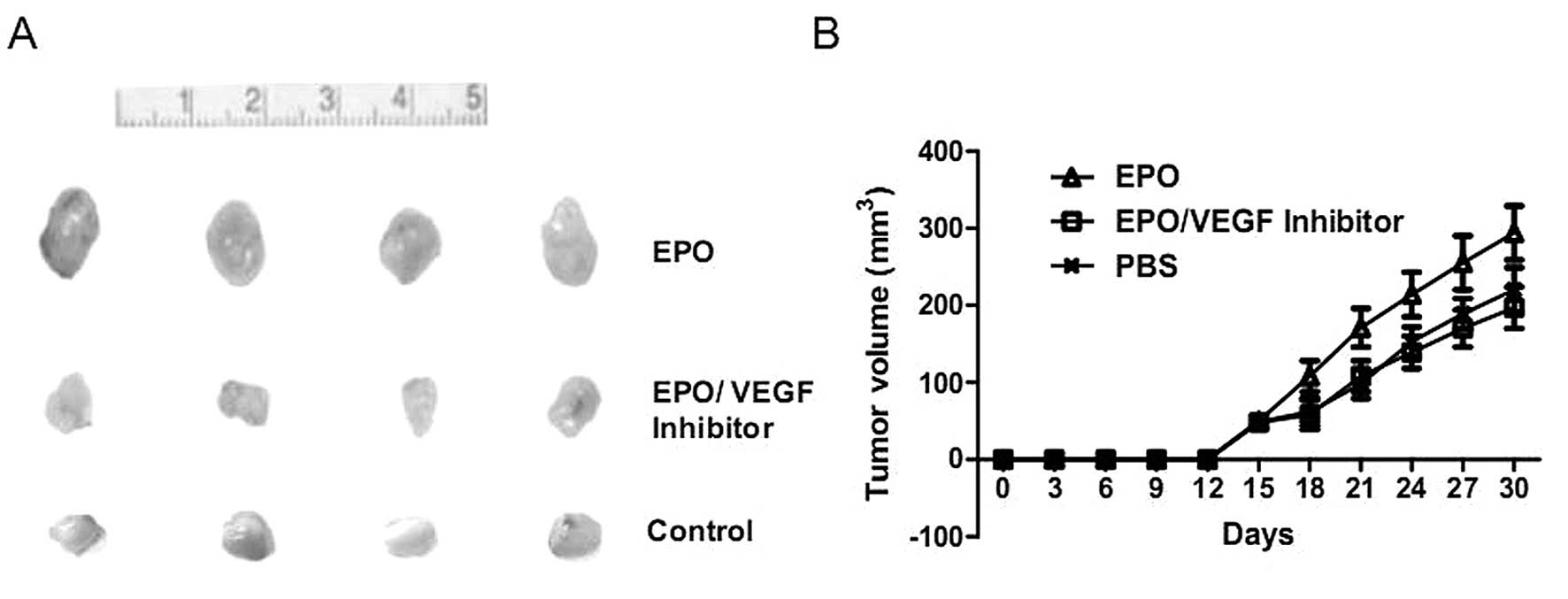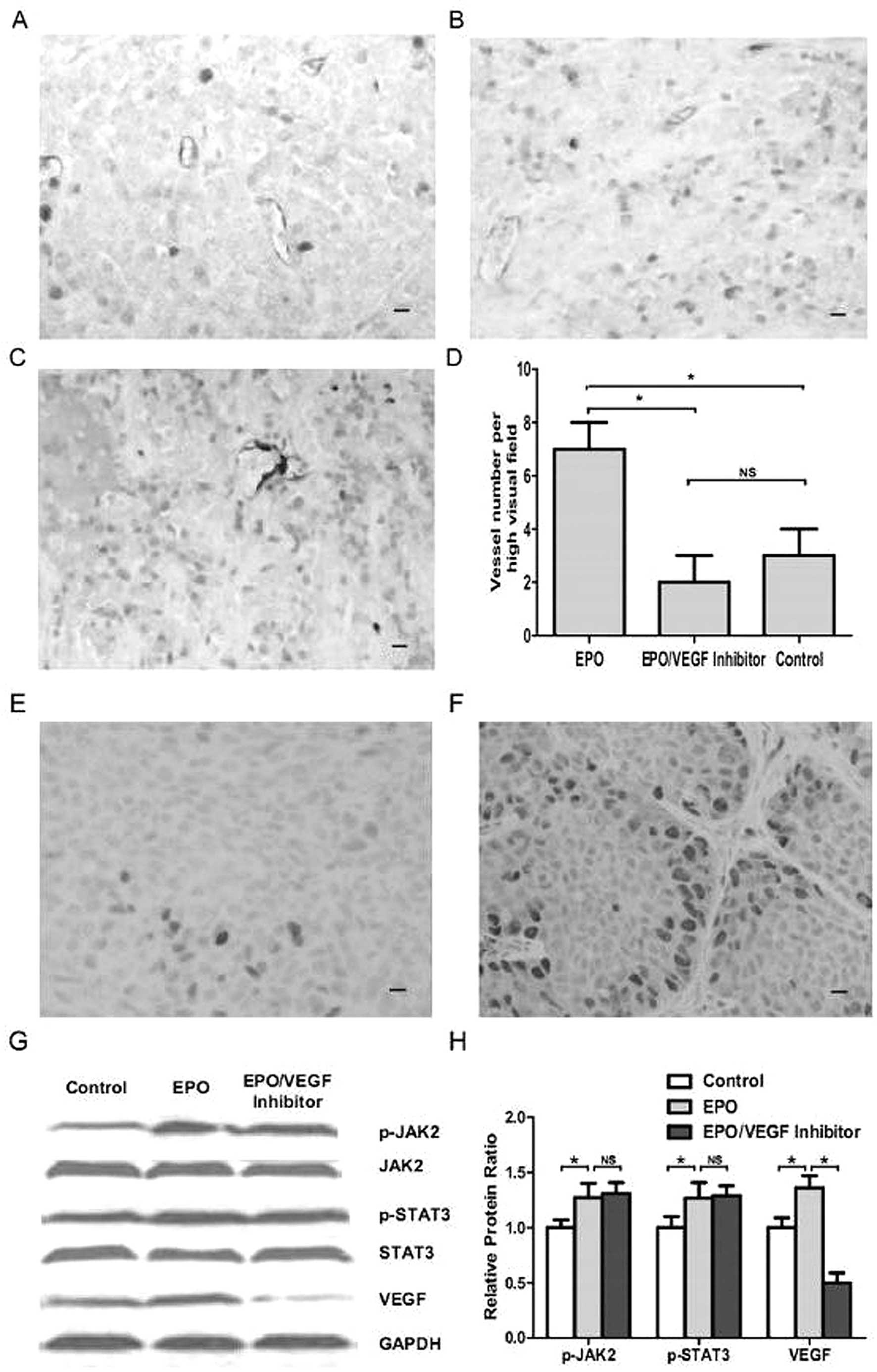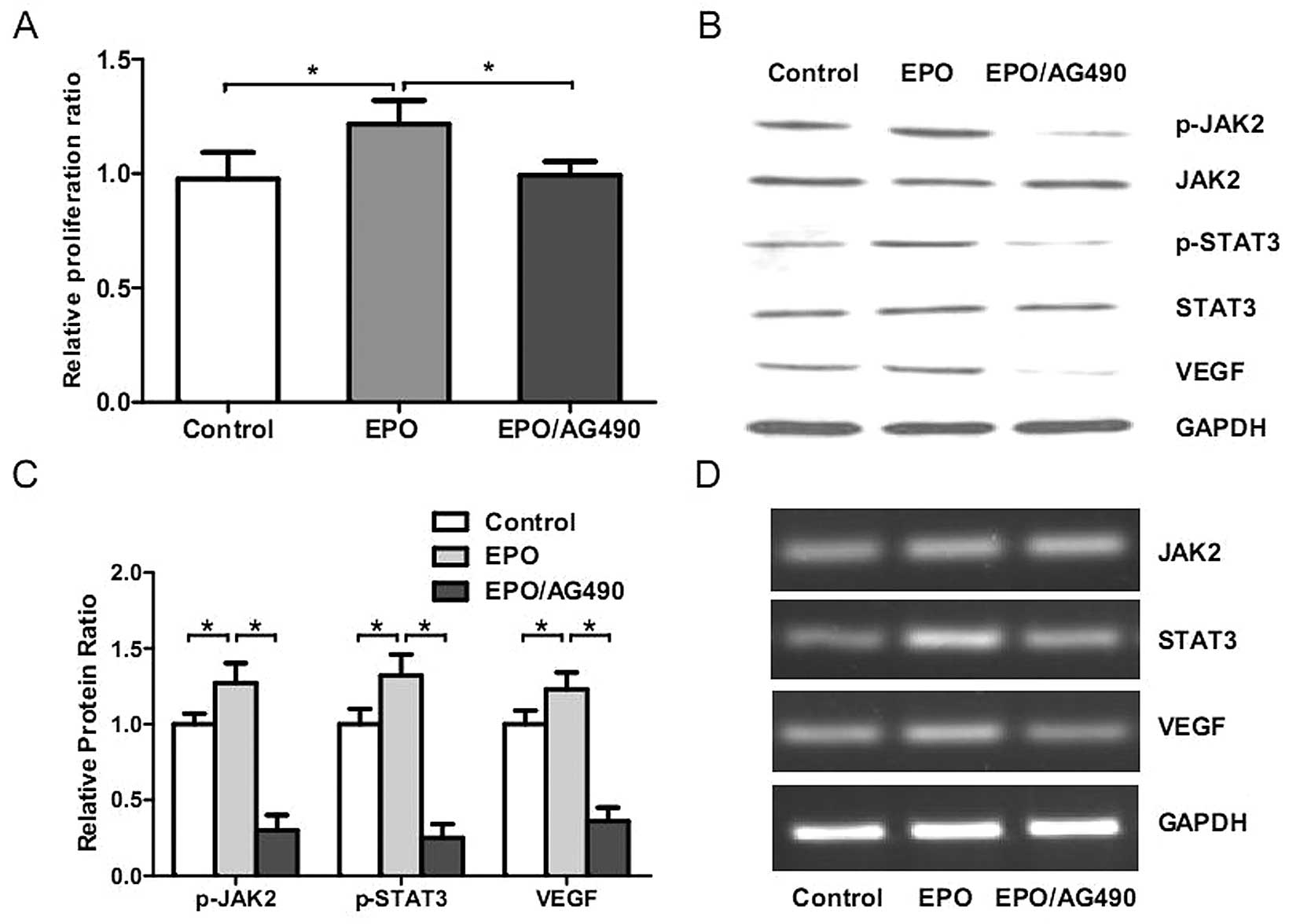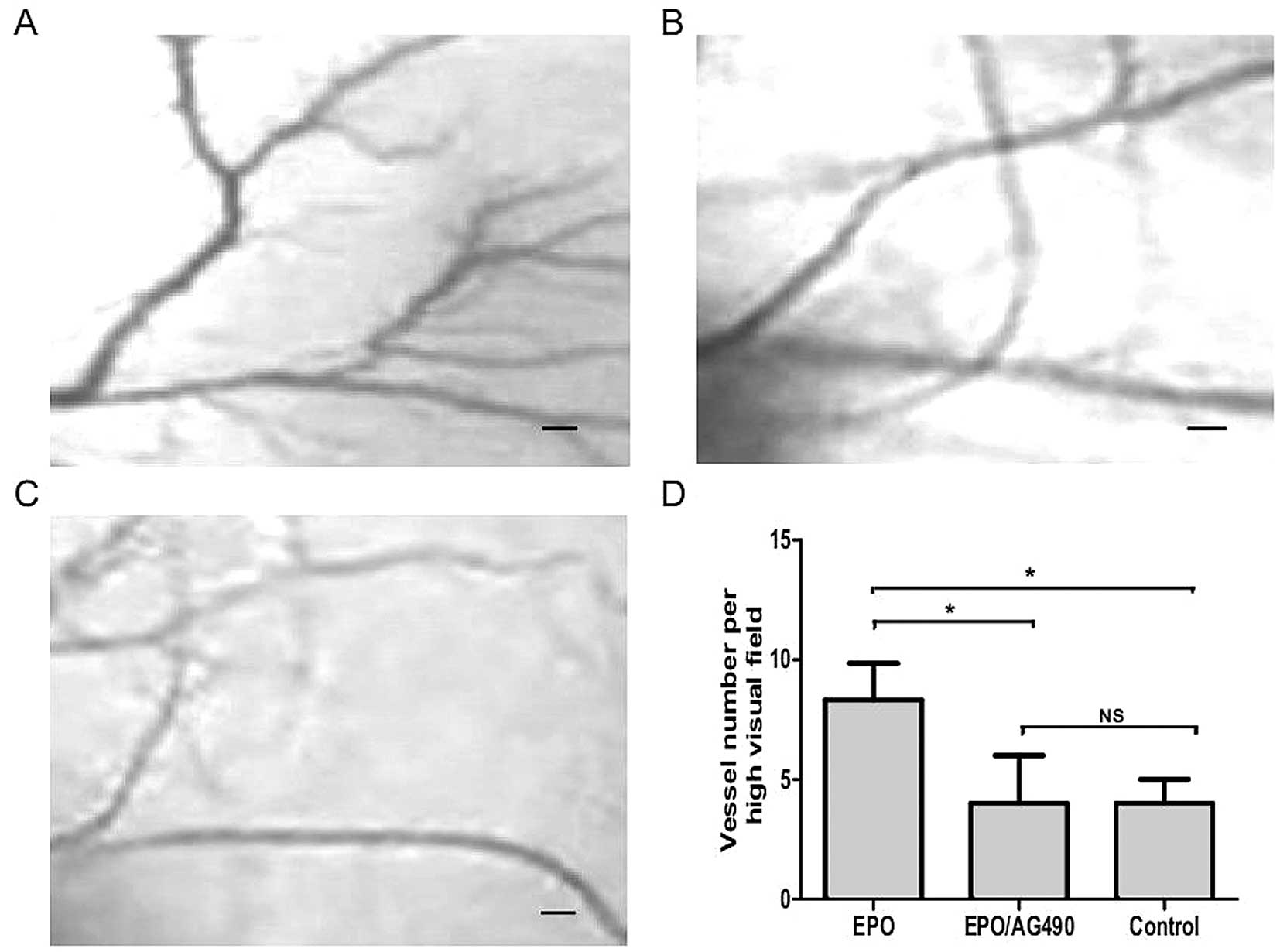Erythropoietin promotes the growth of pituitary adenomas by enhancing angiogenesis
- Authors:
- Published online on: November 11, 2011 https://doi.org/10.3892/ijo.2011.1261
- Pages: 1230-1237
Abstract
Introduction
Recombinant human erythropoietin (rhEPO) has long been used to treat anemia in many clinical settings, such as kidney failure, bone marrow disease, chemotherapy and radiotherapy (1). However, recently the non-hematopoietic biological effects of erythropoietin have been reported because of ubiquitous EPOR expression in non-erythroid cells (2–6). Among these, deleterious effects of therapeutically administered rhEPO on solid tumors have received a great deal of attention.
In 2003, solid tumor patients treated with rhEPO in two large clinical trials displayed increased mortality (2,3). Since then, many clinical studies have reported increased tumor progression, tumor growth and mortality in rhEPO treated solid tumor patients (3,6–11). Furthermore, numerous basic experimental studies also confirmed these deleterious effects in many types of tumors, including renal, breast, lung, prostate, ovarian, head and neck squamous cell carcinomas (12–17). So far, whether rhEPO administration demonstrates similar adverse effect on pituitary adenoma has not been deciphered. Since many patients bearing pituitary adenomas receive conservative treatment and anemia is common in these patients, especially those with macroprolactinomas (17–19), unveiling the potential risk of rhEPO on pituitary adenomas has high clinical value in guiding clinicians who care for anemia patients with pituitary adenomas.
In the present study, we first characterized EPOR expression in different hormone secreting types of human pituitary adenomas and found no EPOR protein expression in pituitary adenomas. Next, we investigated for the first time the effect of rhEPO administration on pituitary adenomas using a nude mouse xenograft model of rat MMQ prolactin-secreting pituitary adenoma cells. Furthermore, we also explored the underlying mechanism in human umbilical vein endothelial cells (HUVECs) in vitro and in chicken chorioallantoic membrane (CAM) angiogenesis model in vivo. Our results indicate that, at least in our cases, pituitary adenomas are EPOR-negative tumors and rhEPO administration accelerates the growth of pituitary adenomas by promoting tumor angiogenesis via the EPO-JAK2-STAT3-VEGF signaling pathway.
Patients and methods
Patients and samples
A series of 31 pituitary adenoma samples were obtained with pathological diagnosis and informed consent. All patients (12 men, 19 women; age range 16–63, mean age 43.50±11.00) years received surgery between April 2009 and April 2011 at the Department of Neurosurgery, the First Affiliated Hospital of Henan University of Science and Technology, Luoyang, China. Of these patients, 19 had prolactinomas, four had non-functional adenomas, two had multihormonal adenomas, four had gonadotropinomas and two had GH-secreting adenomas. For each sample, one half was immediately frozen at -80°C until protein extraction, the other half was fixed with 10% formalin and embedded in paraffin for histology and immunohistochemical analysis. The study was approved by the Research Ethics Committee of Henan University of Science and Technology. Samples were made anonymous according to ethical standards.
Cell line and nude mice
The MMQ rat prolactin-secreting tumor cell line was used in this study, because prolactinoma is the most prevalent hormone-secreting type of pituitary adenomas and there is no mature human pituitary adenoma cell line to date (20). The MMQ rat prolactin-secreting tumor cell line was from ATCC and maintained in F12 culture medium supplemented with 5% fetal bovine serum (FBS), 10% horse serum, penicillin (100 μg/ml) and streptomycin (100 μg/ml) in a humidified incubator (37°C, 5% carbon dioxide). Human umbilical vein endothelial cells (HUVECs) were from cell culture center of Wuhan University and cultured in M200 culture medium supplemented with 20% fetal bovine serum (FBS), L-gultamine (2 mM) and heparin (50 μg/ml). All animal experiments were conducted in accordance with NIH guidelines and with the approval of the local animal use committee. Six-week-old nude mice were inoculated subcutaneously on the hind flank with MMQ cells (1×106). After two weeks, xenograft tumors formed. Mice were randomized into three groups with four mice in each group. For each group, mice were injected with PBS, rhEPO (2000 U/kg, s.c., Kirin), or rhEPO plus bevacizumab (a VEGF inhibitor, 10 mg/kg, i.p., Roche) twice a week for two weeks, respectively. Tumor size was assessed by caliper measurements twice a week. Mice were sacrificed four weeks after tumor cell inoculation and tumors were excised for further analysis.
Cell viability assay
MMQ cells were seeded on 96-well plates (2000 cells/well), and then cells were treated with various concentrations (0, 1, 5 U/ml) of rhEPO for 24, 72 and 120 h in CO2 incubator. HUVECs were seeded on 96-well plates (5000 cells/well), after attachment, cells were left untreated or treated with rhEPO (5 U/ml), rhEPO (5 U/ml) plus JAK2 inhibitor AG490 (20 μM/l) for 48 h. After treatment duration, the CCK-8 assay reagent was added to each well of the plate and incubated for another 1 h. Absorbance was read at 450 nm using a 96-well plate reader.
Immunohistochemisty staining
For immunohistochemisty, tissue sections were deparaffinized and rehydrated. Antigen retrieval was accomplished with citrate buffer (pH 6.0). Endogenous peroxidase was blocked with 3% hydrogen peroxide. Subsequently, slides were blocked with 10% normal horse serum followed by the primary antibodies incubated overnight at 4°C. Mouse anti-EPOR (M20, Santa Cruz, CA) antibody, mouse anti-PCNA (Santa Cruz) and mouse anti-CD31 antibody (Pharmingen, CA) were used. Then, slides were washed and incubated with the biotinylated secondary antibody for 30 min, followed by ABC reagent (Vector Labs) and diaminobenzidine. Slides were counterstained with hematoxylin and dehydrated by sequential ethanol and xylene. Slides were mounted and analyzed. For microvascular density (MVD) determination, two areas of most intense neovascularization were chosen at low magnification ×100. Three random visual fields (x400) in each area of high vascularisation were recorded. The final microvessel density (MVD) was the mean value of six random visual fields of the two high vascularisation areas.
Western blot analysis
Samples (30 μg of proteins) were electrophoresed on a 10–12% SDS-PAGE gel under reducing conditions and electroblotted onto nitrocellulose membrane. The membrane was blocked in 5% non-fat milk and incubated with primary antibodies overnight at 4°C. Primary antibodies used were anti-JAK2, anti-phospho-JAK2, anti-STAT3, anti-phospho-STAT3 (Millipore, MA), anti-ERK2, anti-phospho-ERK2, anti-AKT1, anti-phospho-AKT1 (Santa Cruz, CA), anti-VEGF (Pharmingen, CA). After washing, blots were incubated in secondary antibody (1:5000) for 1 h. ECL substrate was used for signal detection and GAPDH for internal control. The intensity of bands was quantified by densitometric analysis. Results were expressed as the ratio of intensity to that of internal control.
Semiquantitative RT-PCR
Total RNA was isolated from cultured cells using TRIzol reagent (Invitrogen) according to the manufacturer’s protocol, complementary DNA was synthesized using reverse transcription reagent kit (Applied Biosystems). RT-PCR analysis was performed using the following primers: human JAK2 forward 5′-TTATGGACAACAGTCAAACAACAATTC-3′ and reverse 5′-CTTACTCTCGTCTCCACAAAA-3′. Human STAT3 forward 5′-CAAAACCCTCAAGAGCCAAGG-3′ and reverse 5′-TCACTCACAATGCTTCTCCGC-3′. Human VEGF forward 5′-CGAAGTGGTGAAGTTCATGGATG-3′ and reverse 5′-TTCTGTATCAGTCTTTCCTGGTGAG-3′. Human GAPDH forward 5′-GCTTTTAACTCTGGTAAAGTGG-3′ and reverse 5′-TCACGCCACAGTTTCCCGGAGG-3′. The PCR reactions were initiated with denaturation at 95°C for 5 min; followed by 30 amplification cycles at 95°C (30 sec), 58°C (30 sec) and 72°C (30 sec), then finally 72°C (10 min) and 4°C. The relative amount of gene was normalized against GAPDH mRNA.
Chicken chorioallantoic membrane (CAM) angiogenesis model
Chicken eggs were kept in a 37°C, 60% humidity incubator for 9 days. The CAM was dropped and the window sealed with stretchy tape. Fibrous membranes diluted with rhEPO (5 U/ml), rhEPO plus AG490 (20 μM/l) or PBS were placed on the avascular area of the Chicken chorioallantoic membrane. After 3 days, the chicken chorioallantoic membrane was fixed in 4% paraformaldehyde in PBS, dissected and photographed using stereomicroscope equipped with a Digital camera for further angiogenesis analysis.
Statistical analysis
Statistical analysis was conducted with the aid of SPSS 16.0 software. Data are expressed as mean ± SEM. Data obtained from two groups were analyzed by Student’s t-test. P-values <0.05 were considered significant.
Results
No presence of EPOR expression in human pituitary adenoma tissue and MMQ pituitary adenoma cells
Since the EPO-EPOR signaling has never been investigated in human pituitary adenomas, we first assessed the EPOR expression in 31 human pituitary adenoma samples using immunohistochemistry and Western blotting. HepG2 human hepatoma cells and glioma tissue, known EPOR-positive cells and tissue, were used as positive control. In this study, we found no EPOR protein expression in pituitary adenoma samples (Fig. 1). Moreover, similar results were also found in MMQ pituitary adenoma cells (Fig. 1). These data demonstrate that, at least in our cases, pituitary adenomas are EPOR-negative tumors and MMQ cells are EPOR-negative cells.
No proliferative effect of rhEPO on MMQ cells in vitro
To further analyze the effect of rhEPO on pituitary adenomas, the potential proliferative effect of rhEPO was evaluated on MMQ cells in vitro. MMQ cells were starved in F12 medium containing 1% FBS for 48 h, and then co-cultured with rhEPO (0, 1, 5 U/ml) for 24, 72 and 120 h. As expected, no proliferative response was observed in MMQ cells when rhEPO were used as stimulator (Fig. 2A), indicating that rhEPO has no proliferative effect on MMQ cells in vitro.
No rhEPO-induced signaling pathways were activated in MMQ cells in vitro
JAK2/STAT3, MAPK/ERK, and PI3K/AKT pathways are known to be the classic EPO-activated signaling pathways. Moreover, some of these pathways have been reported to be activated in some non-proliferative responding cancer cell lines. Therefore, we determined whether 48 h rhEPO (5 U/ml) stimulation can activate these classic pathways using Western blotting and found no increased tyrosine phosphorylation of JAK2, ERK2 and AKT in MMQ cells treated with rhEPO (Fig. 2B). These results indicate that rhEPO has no influence on these classic EPO-induced signaling pathways in MMQ cells in vitro.
rhEPO administration is associated with increased tumor growth and angiogenic response in vivo
As rhEPO demonstrated no direct effect on MMQ cells in vitro, we further examined whether rhEPO regulate tumor growth of pituitary adenomas in vivo using a nude mouse xenograft model of MMQ prolactin-secreting pituitary adenoma cells. Contrary to our in vitro results, we found that a two-week rhEPO administration (2000 U/kg, twice per week) significantly accelerated tumor growth (Fig. 3). Because rhEPO has been shown to promote proliferation of human endothelial cells and cerebral arteries express EPOR, in seeking the underlying mechanism of the in vivo rhEPO-induced tumor growth acceleration, we evaluated the microvessel density and tumor cell proliferation using immunohistochemisty staining of anti-CD31 and anti-PCNA antibodies and found significantly higher microvessel density (P<0.05, Fig. 4A–D) and increased tumor cell proliferation (P<0.05, Fig. 4E and F) in rhEPO treated xenograft tumors than control ones. Moreover, immunoreactivity for PCNA in EPO treated xenografts showed that tumor cells in peri-vessel areas displayed higher proliferation, which was indicated as increased PCNA staining (Fig. 4F). These results suggest a key role of angiogenesis in the rhEPO induced tumor growth acceleration in MMQ cell xenografts.
Increased VEGF expression and phosphorylation of JAK2 in rhEPO treated MMQ cell xenograft tumors
Since rhEPO promotes angiogenesis in MMQ cell xenografts in vivo without direct effect on MMQ cells in vitro, and VEGF has been reported to play a key role in angiogenesis, in order to characterize signaling pathways involved in rhEPO induced in vivo tumor growth acceleration, Western blot analysis was carried out to measure VEGF expression of rhEPO treated xenografts. Being classic EPO proangiogenic signaling pathway, phosphorylation of JAK2 was also evaluated (21). We found that significant enhanced VEGF expression and phosphorylation of JAK2 in rhEPO treated xenograft tumors (P<0.05, Fig. 4G and H). Based on these observation, we hypothesized that rhEPO induced VEGF signaling may play a key role in its angiogenic effect. As STAT3 has been reported to be required for EPO induced VEGF upregulation (22), we further explored this issue and found significant increased phosphorylation of STAT3 in rhEPO treated xenograft tumors (P<0.05, Fig. 4G and H). The data demonstrate that the EPO-JAK2-STAT3-VEGF signaling axis may be involved in rhEPO induced angiogenesis.
VEGF blockade inhibits rhEPO induced xenograft tumor growth and angiogenesis
To further verify the vital role of angiogenesis in rhEPO induced tumor growth of pituitary adenoma cell xenografts, we administered rhEPO (2000 U/kg) plus bevacizumab (10 mg/kg), a VEGF inhibitor, to nude mice bearing xenograft tumors. After a two-week administration, the bevacizumab administration significantly attenuated EPO-dependent tumor growth and angiogenesis (P<0.05, Figs. 3 and 4). These observations further confirmed the key proangiogenic role of rhEPO in its in vivo tumor growth acceleration.
JAK2 inhibitor AG490 attenuated EPO-induced HUVEC survival, VEGF upregulation and phosphorylation of JAK2 and STAT3
To further verify the involvement of EPO-JAK2-STAT3-VEGF signaling axis in rhEPO-induced angiogenesis, we cultured HUVECs with rhEPO (5 U/ml), rhEPO (5 U/ml) plus AG490 (20 μM/l) or low-serum medium for 48 h, and then CCK8 assay, Western blot analysis and RT-PCR were performed. We found that rhEPO significantly promoted the proliferation (P<0.05, Fig. 5A) and activated JAK2-STAT3-VEGF signaling in HUVECs (P<0.05, Fig. 5B–D). Moreover, AG490 significantly inhibited these EPO-induced effects in vitro (P<0.05, Fig. 5). These results further confirmed the vital role of EPO-JAK2-STAT3-VEGF signaling axis in rhEPO-induced angiogenesis.
AG490 inhibits EPO-induced angiogenesis in the chicken chorioallantoic membrane
To further demonstrate the proangiogenic role of rhEPO more intuitively, we investigated its effect on neovascularisation in the developing chorioallantoic membrane (CAM) of the chicken embryo. As a trigger for angiogenesis, fibrous membrane diluted with rhEPO (5 U/ml) or PBS were placed on the CAM of chicken embryos. After 72 h, vessel formation was significantly increased in EPO treated CAM compared to the control (P<0.05, Fig. 6). As shown in Fig. 6, in contrast, when rhEPO (5 U/ml) plus AG490 (20 μM/l) were further incubated on the CAM for 72 h, AG490 significantly attenuated the EPO induced vessel formation (P<0.05).
Discussion
In this study, for the first time, we present the evidence that pituitary adenomas are EPOR-negative tumors. In addition, rhEPO accelerates pituitary tumor growth in a nude mouse xenograft model of MMQ pituitary adenoma cells accompanied with increased microvessel density and upregulation of JAK2-STAT3-VEGF signaling, whereas rhEPO displays no direct effect on MMQ cells in vitro. Furthermore, EPO promotes HUVECs proliferation and upregulates phosphorylation of JAK2 and STAT3 and VEGF expression, whereas JAK2 inhibitor AG490 significantly attenuated the EPO induced proliferation in HUVECs in vitro and vessel formation in CAM in vivo. Our results suggest that rhEPO may exert its in vivo proliferation effect via enhancement of angiogenesis in pituitary adenomas through EPO-JAK2-STAT3-VEGF signal pathway.
In the present study, a two-week rhEPO administration resulted in accelerated tumor growth of MMQ cell xenografts, suggesting that rhEPO administration can accelerate the tumor growth of EPOR negative pituitary adenomas. rhEPO has to date been described to stimulate tumor growth though both in vitro direct and in vivo indirect effects (23). Specific in vitro growth response to rhEPO has been reported in RCC, breast, prostate, lung and HNSCC cell lines (14,15,23–25). The direct proliferative effect of rhEPO seems to be EPOR-dependent and tumor cell specific, because previous studies have shown that growth response to rhEPO is only on those cells expressing cell-surface EPOR (23,24). Moreover, cells from different organs, even multiple cell lines derived from the same organ, display different growth response to exogenous EPO (23). These discrepancies may be due to different cell lines, different culture conditions or different assay procedures. In the present study, the lack of growth response and signal transduction to rhEPO in MMQ cells in vitro excluded the possibility of the direct proliferative effect of rhEPO on MMQ cells. This is consistent with previous experiments suggesting no proliferative effect of rhEPO on EPOR negative cells (26).
Besides direct proliferative effect on tumor cells, rhEPO has also been suggested as a pro-angiogenic factor, which indirectly promotes tumor growth via angiogenesis (21,27). Because EPOR has been confirmed in various endothelial cells, especially including brain capillary endothelial cells, rhEPO can directly stimulate angiogenesis of both EPOR positive and negative tumors, which in turn provide a growth advantage to tumor cells in vivo (21,26,28,29). Previous studies have documented that rhEPO can not only increase endothelial cell proliferation but also enhance the number of circulating endothelial cells and endothelial precursor cells (21,26). Furthermore, it is noteworthy that rhEPO can stimulate cerebral angiogenesis in vivo and promote capillary tube formation of cerebral endothelial cells by inducing vascular endothelial growth factor (VEGF), all of which provide evidence for the proangiogenic properties of rhEPO (28,30,31). Based on the aforementioned, we hypothesized that rhEPO may indirectly promote tumor growth by enhancing angiogenesis. In order to further clarify this issue, immunohistochemisty of CD31 and PCNA were carried out to investigate the microvessel density and tumor proliferation of MMQ cell xenografts in both rhEPO and control groups. In supporting of our hypothesis, we found increased microvessel density and proliferation in rhEPO treated MMQ cell xenografts. Moreover, tumor cells in peri-vessel areas displayed higher proliferation. These data defined a key proangiogenic role of rhEPO in stimulating the tumor growth of MMQ cell xenografts.
The EPO-JAK2-STAT3-VEGF pathway has been well documented for its essential proangiogenic role in tumor growth acceleration (21). Previous studies have reported that EPO can activate STAT3 and STAT5 in primary cerebral vascular cells (21,28,29). Furthermore, the deletion of the endogenous Epo-EPOR system in nonhematopoietic cells in mice impairs STAT3 activation, VEGF upregulation, and capillary growth (31). Our mechanistic study of MMQ cell xenografts showed that rhEPO administration increased phosphorylation of JAK2, STAT3 and VEGF expression. Moreover, VEGF blockade attenuated rhEPO induced xenograft angiogenesis and tumor growth. These results suggest a key role of the proangiogenic property of rhEPO in its tumor growth promotion of pituitary adenomas. As rhEPO has been reported to stimulate JAK2-STAT3 pathway and STAT3 is required for VEGF upregulation (22,32,33), we further verified this issue and found that JAK2 inhibitor AG490 not only attenuated EPO induced HUVECs survival, phosphorylation of STAT3 and VEGF upregulation in vitro, but also inhibited EPO-induced angiogenesis in the chicken chorioallantoic membrane. These results defined the EPO-JAK2-STAT3-VEGF pathway as an underlying mechanism of the rhEPO proangiogenic property, which in turn promotes tumor growth in pituitary adenomas.
In the present study, we demonstrated that, at least in our cases, pituitary adenomas are EPOR negative tumors and systematic rhEPO administration may promote tumor growth of pituitary adenomans via enhancing angiogenesis though the EPO-JAK2-STAT3-VEGF signal pathway. Based on our results, rhEPO should be used with caution in pituitary adenoma patients due to its potential detrimental proangiogenic and proliferative effect. Further research is needed to fully elucidate the complex interplay between rhEPO and pituitary adenomas, in order to identify whether rhEPO is suitable for use in anemia patients bearing pituitary adenoma.
Acknowledgements
This work was supported by a Grant-in-Aid for Postdoctoral Scientific Research from Henan University of Science and Technology.
References
|
Ng T, Marx G, Littlewood T and Macdougall I: Recombinant erythropoietin in clinical practice. Postgrad Med J. 79:367–376. 2003. View Article : Google Scholar | |
|
Leyland-Jones B: Breast cancer trial with erythropoietin terminated unexpectedly. Lancet Oncol. 4:459–460. 2003. View Article : Google Scholar : PubMed/NCBI | |
|
Henke M, Laszig R, Rube C, et al: Erythropoietin to treat head and neck cancer patients with anaemia undergoing radiotherapy: randomised, double-blind, placebo-controlled trial. Lancet. 362:1255–1260. 2003. View Article : Google Scholar | |
|
Jelkmann W, Bohlius J, Hallek M and Sytkowski AJ: The erythropoietin receptor in normal and cancer tissues. Crit Rev Oncol Hematol. 67:39–61. 2008. View Article : Google Scholar : PubMed/NCBI | |
|
Glaspy JA: Erythropoiesis-stimulating agents in oncology. J Natl Compr Cancer Netw. 6:565–575. 2008. | |
|
Glaspy J, Crawford J, Vansteenkiste J, et al: Erythropoiesis-stimulating agents in oncology: a study-level meta-analysis of survival and other safety outcomes. Br J Cancer. 102:301–315. 2010. View Article : Google Scholar : PubMed/NCBI | |
|
Leyland-Jones B, Semiglazov V, Pawlicki M, et al: Maintaining normal hemoglobin levels with epoetin alfa in mainly nonanemic patients with metastatic breast cancer receiving first-line chemotherapy: a survival study. J Clin Oncol. 23:5960–5972. 2005. View Article : Google Scholar | |
|
Temkin SM, Hellmann M, Serur E, Lee YC and Abulafia O: Erythropoietin administration during primary treatment for locally advanced cervical carcinoma is associated with poor response to radiation. Int J Gynecol Cancer. 16:1855–1861. 2006. View Article : Google Scholar | |
|
Wright JR, Ung YC, Julian JA, et al: Randomized, double-blind, placebo-controlled trial of erythropoietin in non-small-cell lung cancer with disease-related anemia. J Clin Oncol. 25:1027–1032. 2007. View Article : Google Scholar : PubMed/NCBI | |
|
Smith RE Jr, Aapro MS, Ludwig H, et al: Darbepoetin alpha for the treatment of anemia in patients with active cancer not receiving chemotherapy or radiotherapy: results of a phase III, multicenter, randomized, double-blind, placebo-controlled study. J Clin Oncol. 26:1040–1050. 2008. View Article : Google Scholar | |
|
Thomas G, Ali S, Hoebers FJ, et al: Phase III trial to evaluate the efficacy of maintaining hemoglobin levels above 12.0 g/dl with erythropoietin vs above 10.0 g/dl without erythropoietin in anemic patients receiving concurrent radiation and cisplatin for cervical cancer. Gynecol Oncol. 108:317–325. 2008. View Article : Google Scholar | |
|
Lee YS, Vortmeyer AO, Lubensky IA, et al: Coexpression of erythropoietin and erythropoietin receptor in von Hippel-Lindau disease-associated renal cysts and renal cell carcinoma. Clin Cancer Res. 11:1059–1064. 2005.PubMed/NCBI | |
|
Saintigny P, Besse B, Callard P, et al: Erythropoietin and erythropoietin receptor coexpression is associated with poor survival in stage I non-small cell lung cancer. Clin Cancer Res. 13:4825–4831. 2007. View Article : Google Scholar : PubMed/NCBI | |
|
Lai SY, Childs EE, Xi S, et al: Erythropoietin-mediated activation of JAK-STAT signaling contributes to cellular invasion in head and neck squamous cell carcinoma. Oncogene. 24:4442–4449. 2005. View Article : Google Scholar : PubMed/NCBI | |
|
Arcasoy MO, Amin K, Vollmer RT, Jiang X, Demark-Wahnefried W and Haroon ZA: Erythropoietin and erythropoietin receptor expression in human prostate cancer. Mod Pathol. 18:421–430. 2005. View Article : Google Scholar : PubMed/NCBI | |
|
Jeong JY, Feldman L, Solar P, Szenajch J and Sytkowski AJ: Characterization of erythropoietin receptor and erythropoietin expression and function in human ovarian cancer cells. Int J Cancer. 122:274–280. 2008. View Article : Google Scholar : PubMed/NCBI | |
|
Acs G, Acs P, Beckwith SM, et al: Erythropoietin and erythropoietin receptor expression in human cancer. Cancer Res. 61:3561–3565. 2001.PubMed/NCBI | |
|
Ellegala DB, Alden TD, Couture DE, Vance ML, Maartens NF and Laws ER Jr: Anemia, testosterone, and pituitary adenoma in men. J Neurosurg. 98:974–977. 2003. View Article : Google Scholar : PubMed/NCBI | |
|
Shimon I, Benbassat C, Tzvetov G and Grozinsky-Glasberg S: Anemia in a cohort of men with macroprolactinomas: increase in hemoglobin levels follows prolactin suppression. Pituitary. 14:11–15. 2011. View Article : Google Scholar : PubMed/NCBI | |
|
Aron DC, Tyrrell JB and Wilson CB: Pituitary tumors. Current concepts in diagnosis and management. West J Med. 162:340–352. 1995.PubMed/NCBI | |
|
Ribatti D: Erythropoietin and tumor angiogenesis. Stem Cells Dev. 19:1–4. 2010. View Article : Google Scholar | |
|
Funamoto M, Fujio Y, Kunisada K, et al: Signal transducer and activator of transcription 3 is required for glycoprotein 130-mediated induction of vascular endothelial growth factor in cardiac myocytes. J Biol Chem. 275:10561–10566. 2000. View Article : Google Scholar : PubMed/NCBI | |
|
Szenajch J, Wcislo G, Jeong JY, Szczylik C and Feldman L: The role of erythropoietin and its receptor in growth, survival and therapeutic response of human tumor cells From clinic to bench - a critical review. Biochim Biophys Acta. 1806:82–95. 2010.PubMed/NCBI | |
|
Hardee ME, Arcasoy MO, Blackwell KL, Kirkpatrick JP and Dewhirst MW: Erythropoietin biology in cancer. Clin Cancer Res. 12:332–339. 2006. View Article : Google Scholar : PubMed/NCBI | |
|
Mohyeldin A, Lu H, Dalgard C, et al: Erythropoietin signaling promotes invasiveness of human head and neck squamous cell carcinoma. Neoplasia. 7:537–543. 2005. View Article : Google Scholar : PubMed/NCBI | |
|
Okazaki T, Ebihara S, Asada M, Yamanda S, Niu K and Arai H: Erythropoietin promotes the growth of tumors lacking its receptor and decreases survival of tumor-bearing mice by enhancing angiogenesis. Neoplasia. 10:932–939. 2008.PubMed/NCBI | |
|
Ribatti D, Vacca A, Roccaro AM, Crivellato E and Presta M: Erythropoietin as an angiogenic factor. Eur J Clin Invest. 33:891–896. 2003. View Article : Google Scholar : PubMed/NCBI | |
|
Ribatti D, Poliani PL, Longo V, Mangieri D, Nico B and Vacca A: Erythropoietin/erythropoietin receptor system is involved in angiogenesis in human neuroblastoma. Histopathology. 50:636–641. 2007. View Article : Google Scholar : PubMed/NCBI | |
|
Anagnostou A, Lee ES, Kessimian N, Levinson R and Steiner M: Erythropoietin has a mitogenic and positive chemotactic effect on endothelial cells. Proc Natl Acad Sci USA. 87:5978–5982. 1990. View Article : Google Scholar : PubMed/NCBI | |
|
Hardee ME, Cao Y, Fu P, et al: Erythropoietin blockade inhibits the induction of tumor angiogenesis and progression. PLoS One. 2:e5492007. View Article : Google Scholar : PubMed/NCBI | |
|
Asaumi Y, Kagaya Y, Takeda M, et al: Protective role of endogenous erythropoietin system in nonhematopoietic cells against pressure overload-induced left ventricular dysfunction in mice. Circulation. 115:2022–2032. 2007. View Article : Google Scholar : PubMed/NCBI | |
|
Osugi T, Oshima Y, Fujio Y, et al: Cardiac-specific activation of signal transducer and activator of transcription 3 promotes vascular formation in the heart. J Biol Chem. 277:6676–6681. 2002. View Article : Google Scholar : PubMed/NCBI | |
|
Hilfiker-Kleiner D, Limbourg A and Drexler H: STAT3-mediated activation of myocardial capillary growth. Trends Cardiovasc Med. 15:152–157. 2005. View Article : Google Scholar : PubMed/NCBI |



